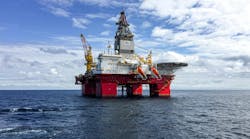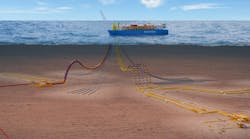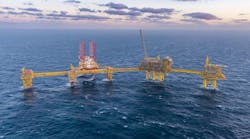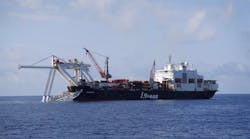With industry focus on the established players and the big plays offshore West Africa, much of the region’s nascent activity has been overlooked. The new prospects could well be as promising as some of the giants now moving into production, but because they are overshadowed by the mammoth developments, few are aware that new areas are being explored.
A lot of exploration dollars are going to Africa, and some of it is going to under-explored and unexplored areas.
East coast prospects
Some of the newest plays are on Africa’s east coast, which, for the most part, has seen very little drilling. The most interesting activity is offshore Kenya, Tanzania, and Mozambique.
After nearly two decades of inactivity, drilling is under way again offshore Kenya. In mid-December 2006, Australia’s Woodside Energy Ltd. set 51-mm (20-in) casing at 2,944 m (9,659 ft), 751 m (2,464 ft) below the seabed at the Pomboo No. 1 well in license L-5 in the Lamu basin.
According to Woodside, operator of L-5, the company identified east Africa several years ago as an under-explored frontier with the potential to replicate the company’s success in Mauritania on the west coast.
Entry into these regions provided Woodside with a relatively low-cost initial investment in a very large under-explored area.
Woodside acquired 40% interest in Kenya’s L-5 license along with three other blocks from Dana Petroleum Plc. subsidiary Dana Petroleum (E&P) Ltd. in May 2003. At that time, Woodside agreed to operate blocks L-5, L-7, L-10, and L-11 as a condition of the farm-in.
The four blocks cover 47,500 sq km (18,340 sq mi) in water depths to 3,000 m (9,842 ft). The licenses also include some onshore areas and coastal waters.
Partners on L-5 include Dana Petroleum (E&P) Ltd., Repsol, and Global Petroleum Ltd.
Woodside considers Kenya on the east coast and Sierra Leone and Liberia on the west coast to be promising under-explored, frontier areas with significant potential. The company has considerable exploration interests in all of these regions.
In April 2006, Aminex Plc. entered into a seismic option agreement with Upstream Petroleum Services Ltd. over blocks L9 and L10.
Under UPSL’s technical evaluation agreement, 570 km (1,931 mi) of new 2D seismic data were acquired over the area as well as geochemical seabed coring and additional seismic on prospective leads.
The agreement covers about 5,000 sq km (354 sq mi), of land and near-shore acreage in the original Kenyan blocks L9 and L10.
Last December, Australia’s Origin Energy began the early stages of its Kenyan exploration program with a 3,200 km (1,988 mi) seismic survey in Lamu basin blocks L8 and L9. Origin holds an option to extend the program by 600 km (373 mi).
The program objective is to define 40 mapped leads by the time the survey is complete in February 2007.
In December 2005, Pancontinental Oil & Gas farmed out 75% of blocks L8 and L9 to Origin Energy in return for full funding of the $4-million seismic program and the drilling of an exploration well in each block.
Pancontinental also holds an interest in block L6, where Gippsland Offshore Petroleum Ltd. is expected to begin a seismic program with the same contractor upon completion of the Origin Energy survey.
“Blocks L6, L8, and L9 contain targets that are of the same type as in the two Woodside-operated permits, blocks L5 and L7,” says Andrew Svalbe, Pancontinental CEO.
With the number of operators looking for targets in this region, Kenya’s offshore is likely to see a discovery soon.
Tanzania
Last January, EnerGulf submitted its proposed production sharing agreement to the Tanzania Petroleum Development Commission (TPDC).
The company’s 8,000-sq-km (4,971-sq-mi) Tanga block has potential for several significant petroleum accumulations, but no further activity has taken place on the block.
In 2Q 2006, Aminex began acquiring a new 2D survey in the Area B transition zone of the Nyuni license, offshore Tanzania. Aminex acquired 330 km (205 mi) of new conventional 2D seismic data over this area in 2005. The transition zone data is particularly important at Nyuni, where the majority of the potential drilling locations underlie shoals, limestone reefs, and small islands, many of which are partly submerged at high tide.
The aim of the survey was to establish drilling targets for exploration wells.
Last April, Aminex signed a farm-out agreement with East African Exploration Ltd., a Dubai-based oil and gas exploration company. The agreement provided for EAX to earn into part of the Nyuni license by acquiring new transition zone 2D seismic data over Area B of the license.
Area A of the Nyuni license in Tanzania was partly farmed out to East Coast Energy the previous year.
Mozambique
In late December 2006, Anadarko Petroleum Corp. signed an exploration and production concession contract with the government of Mozambique for Offshore Area 1 in the Rovuma basin. Anadarko was awarded the block in Mozambique’s second licensing round earlier in the year.
The 2.6-million-acre block includes 90,000 onshore acres and stretches eastward 56 km (35 mi) offshore into 1,800 m (6,000 ft) water depth. The block’s boundary borders Tanzania to the north and extends southward 160 km (100 mi).
“Offshore Area 1 is a ground-floor opportunity to explore the highly prospective Rovuma basin, where only two wells have ever been drilled,” says Bob Daniels, Anadarko senior VP of worldwide exploration. “Through our regional evaluation and analysis of existing seismic data covering most of the block, we have already identified multiple leads across an area equivalent in size to 460 typical Gulf of Mexico lease blocks.”
Under the terms of the contract, Anadarko has a five-year initial exploration term with options to extend that phase another three years, and a 30-year production term following any commercial discoveries. Anadarko will acquire new 2D and 3D seismic data, and will drill seven wells during the initial exploration term.
Anadarko operates the block with 100% working interest.
Petroliam Nasional Bhd (Petronas) won bids for two exploration oil and gas blocks, Area 3 and Area 6, in the same basin as Anadarko’s block. Italy’s ENI won the other offshore license. Seven foreign countries were involved in the bidding process.
Petronas first entered Mozambique’s oil and gas industry when it was awarded an EPC contract for offshore Zambezi Delta block in June 2002, with Empresa Nacional de Hidrocarbonetos de Mozambique (ENH) as partner.
Under the terms of the EPC, Petronas Carigali Mozambique E&P Ltd. holds an 85% interest in the block, with ENH holding the remaining 15%. Petronas Carigali Mozambique operates the block.
The Zambezi Delta block covers 9,054 sq km (5,626 sq mi) offshore in up to 2,000 m (6,562 ft) water depth. The basin, within which the block is located, has a proven hydrocarbon system with discoveries of several onshore gas fields.
Mozambique will see more drilling once the seismic analysis determines the biggest targets. Expect more exploration news from the area.
West coast frontiers
Senegal’s Petrosen, the national oil company, created in 1981, is responsible for exploration activity in the country.
Over the past 50 years, the Senegalese offshore has seen nearly 50 exploration wells, half of which were in the Casamance offshore. The rest of the Senegal basin remains under-explored.
Most of the discoveries have been oil, with primary production coming from the Dome Flore and Gea fields, jointly operated by Senegal and Guinea-Bissau. Senegal receives 85% of the production proceeds from the area. Thirteen wells have been drilled on the Dome Flore block, with several penetrating heavy oil deposits. Two wells have hit lighter crude, though in smaller quantities, about 70 km (43 mi) offshore in 50 m (164 ft) of water.
The primary activity in the area is a 1,500-sq-km (579-sq-mi) 3D seismic survey that Edison Spa and partner Petrobras planned to begin at the end of last year over the eastern part of the Rufisque Offshore Profond license.
Energy Africa acquired the St. Louis exploration license with Petrosen in late 2003. Tullow operates the license with a 60% interest, having farmed out 30% to Dana in late 2004. Petrosen holds the remaining 10%.
The license covers the northernmost inshore section of the Senegalese offshore area and adjoins Mauritanian block 1 in which the company has a 20% interest. Tullow acquired a 1,200 km (746 mi) 2D survey in 2004 and subsequent interpretation identified various prospects which are currently under further evaluation.
Guinea-Bissau
Guinea-Bissau’s offshore has been active since the late 1960s, when Esso drilled six wells. Very little exploration has taken place since, partially because the country has not had a stable enough government for much of the time since and partially because of an offshore boundary dispute with Senegal that wasn’t resolved until the mid-1990s.
The agreement with Senegal resulted in joint management of the Dome Flore and Dome Gea discoveries, which nets Guinea-Bissau 15% of the proceeds from activity in the area.
All of the offshore exploration has been in the Sinapa and Esperanca permits in the shallow water of the Casamance-Bissau sub-basin. Together, the Sinapa (block 2) and the Esperanca (blocks 4A and 5A) permits, cover 5,840 sq km (2,116 sq mi) in 10-2,000 m (33-6,562 ft) water depths.
Beginning in 2001, Premier Oil has carried out 3D seismic data acquisition, followed by drilling the Sinapa-2 well and Sinapa-2Z sidetrack, which discovered non-commercial levels of oil.
Premier Oil planned to start Eirozes (190 MMbbl potential) and Espinafre (70 MMbbl potential) wells in January 2007.
Liberia and Sierra Leone
In early 2005, Woodside acquired exploration acreage off Liberia in the country’s first offshore licensing round.
Woodside’s acreage adjoins blocks held by its joint venturer, Repsol, in neighboring Sierra Leone. Woodside and Repsol each hold a 50% interest in two blocks immediately west of Liberia in Sierra Leone, giving them interests in five adjoining blocks across Sierra Leone and Liberia.
Woodside’s initial four-year work commitment in Liberia includes geological and geophysical studies, including acquiring 600 km (373 mi) of 2D seismic data and 1,600 sq km (618 sq mi) of 3D seismic data.
Cameroon
In December 2002, Tullow and Addax Petroleum signed an exploration license with the Cameroon government for the shallow-water Ngosso area, which contains small oil discoveries, including Narendi, Odiong, and Oongue. These discoveries still are undergoing appraisal.
One of the objectives of the initial work program is to appraise these discoveries with a view to establishing commerciality.
A 3D survey, covering 207 sq km (80 sq mi), was completed in 1Q 2006. There is a chance that up to two wells will be drilled this year, most likely in 4Q.
Judy Maksoud
International Editor






